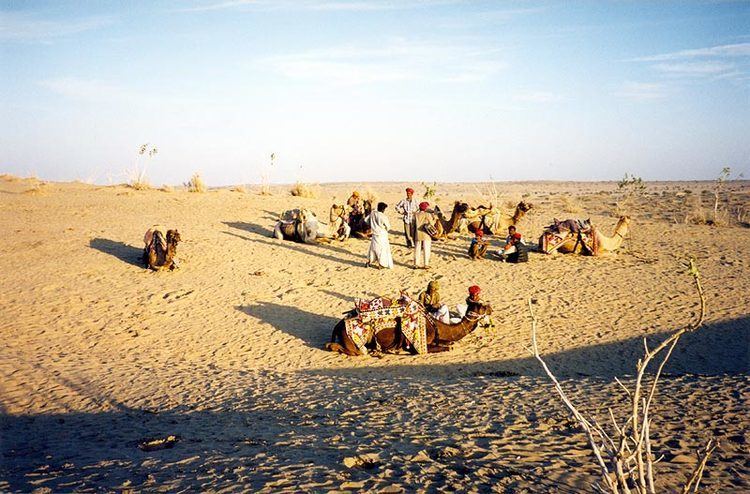 | ||
Rajasthan has artistic and cultural traditions which reflect the ancient Indian way of life. There is a rich and varied folk culture from villages which is often depicted as symbolic of the state.
Contents
- Music and dance
- Arts and crafts
- Architecture
- Forts of Rajasthan
- Palaces of Rajasthan
- Religion
- Festivals
- Bhakti Cult and Religious syncretism
- References
Rajasthan had a glorious history. It is known for many brave kings, their deeds; and their interest in art and architecture. Its name means “the land of the rajas”. It was also called Rajputana (the country of the Rajputs); whose codes of chivalry shaped social mores just as their often bitter and protracted feuding dominated their politics.
Rajasthan, the land of Kings, has royal grandeur and a glorious history; it is a charming and captivating state of India. It is a tourism destination with lots of tourist attractions and good tourist facilities. This historical state of India attracts tourists and vacationers with its rich culture, tradition, heritage, and monuments. It is also rich in its flora and fauna with some of popular wildlife sanctuaries & national parks.
More than 70% of Rajasthan is vegetarian, which makes it the most vegetarian state in India.
Music and dance
Highly cultivated classical music and dance with its own distinct style is part of the cultural tradition of Rajasthan. The music is uncomplicated and songs depict day-to-day relationships and chores, more often focused around fetching water from wells or ponds.
The Ghoomar dance from Udaipur and Kalbeliya dance of Jaisalmer have gained international recognition. Folk music is a vital part of Rajasthani culture. Kathputali, Bhopa, Chang, Teratali, Ghindar, Kachchhighori, Tejaji,parth dance etc. are the examples of the traditional Rajasthani culture. Folk songs are commonly ballads which relate heroic deeds and love stories; and religious or devotional songs known as bhajans and banis (often accompanied by musical instruments like dholak, sitar, sarangi etc.) are also sung.
Kanhaiya Geet also sung in major areas of east rajasthani belt in the collectiong manner as a best source of entertainment in the rural areas.
Arts and crafts
Rajasthan is famous for textiles, semi-precious stones and handicrafts, and for its traditional and colorful art. Rajasthani furniture has intricate carvings and bright colours. Block prints, tie and dye prints, Bagaru prints, Sanganer prints and Zari embroidery are major export products from Rajasthan. The blue pottery of Jaipur is particularly noted.
Architecture
Rajasthan is famous for its many historical forts, temples and palaces (havelis), which predominantly drives tourism in the state.
Forts of Rajasthan
Palaces of Rajasthan
Religion
Rajasthan is home to all the major religions of India. Hindus are the largest in number, accounting for 87.45% of the population. Muslims (10.08%), Sikhs (1.27%), Jains (1%) and Sindhi's constitute the remaining of the population.
Festivals
The main religious festivals are Deepawali, Holi, Gangaur, Teej, Gogaji, Makar Sankranti and Janmashtami, as the main religion is Hinduism. Rajasthan's desert festival is celebrated with great zest and zeal. This festival is held once a year during winters. Dressed in brilliantly hued costumes, the people of the desert dance and sing ballads of valor, romance and tragedy. There are fairs with snake charmers, puppeteers, acrobats and folk performers. Camels play a prominent role in this festival.
Bhakti Cult and Religious syncretism
Rajasthan has several popular Hindu saints, many from the Bhakti era.
Rajasthani saints hail from all castes; Maharshi Naval Ram and Umaid Ram Maharaj were Bhangis, Karta Ram Maharaj was a Shudra, Sundardasa was a Vaish, and Meerabai and Ramdeoji were Rajputs. The backward caste Nayaks serve as the narrators or the devotional music (or "bhajan") for the Baba Ramdevji sect.
The most popular Hindu deities are Surya, Krishna and Rama.
Modern-day popular saints from Rajasthan have been Paramyogeshwar Sri Devpuriji of Kriya Yoga and Swami Satyananda the master of Kriya Yoga, Kundalini Yoga, Mantra Yoga and Laya yoga. Rajasthan had a massive movement to unite the Hindus and Muslims to worship God together. Saint Baba Ramdevji was adored by Muslims, equally that he was to Hindus.
Mostly Rajasthani speaks Marwari language.It is their native language.
Saint Dadu Dayal was a popular figure who came from Gujarat to Rajasthan to preach the unity of Ram and Allah. Sant Rajjab was a saint born in Rajasthan who became a disciple of Dadu Dayal and spread the philosophy of unity amongst Hindu and Muslim worshipers of God.
Saint Kabir was another popular figure noted for bringing the Hindu and Muslim communities together, and stressing that God may have many forms (e.g., whether in the form or Rama or Allah.)
